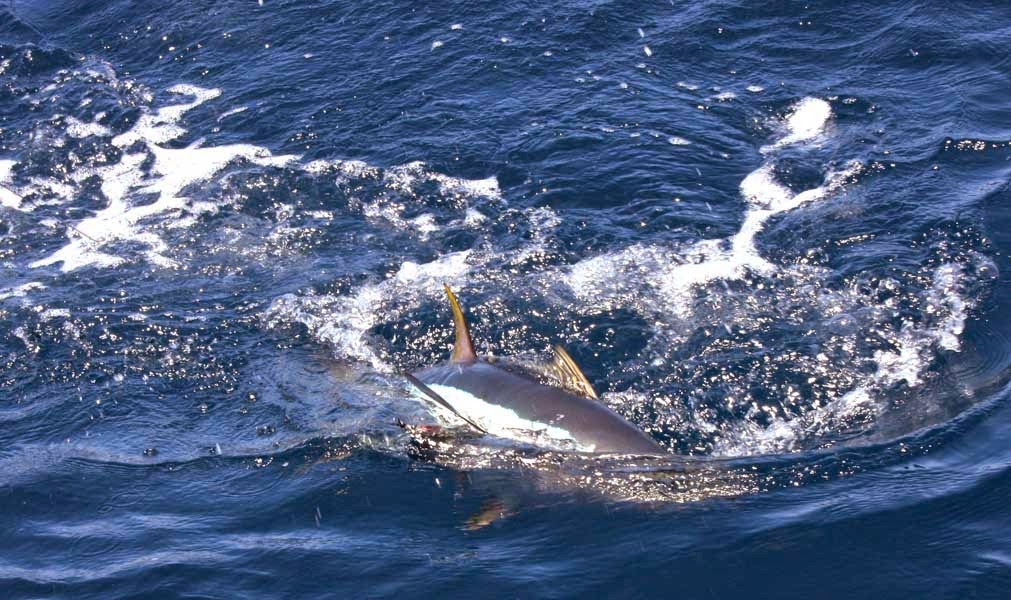We have Yellow Fin Tuna (Thunnus Albacares) visit our waters by the second week of March almost every year and can be found quite close to land for the next few months. Catch statistics show they are in our waters in the highest concentrations in the month of June. They are a pelagic species, which means they mostly live in the open ocean and do not live near the sea floor, although they may spend part of their life cycle in comparatively shallower waters close to the coastline.
Yellow Fin Tuna can be found in most places along the Equator and just extend roughly to 40°N and to roughly 35°S. They can survive in seas within the temperature range of 10°C-33°C. They prefer warmer clean water and areas of low turbidity. They can be most commonly found near and around marine habitats such as drop-offs and the continental shelf. Yellow Fin tuna have often been found with schools of different species of Dolphins and other big fish. They are an oceanic species occurring above and below thermocline. They school primarily by size, either in mono-specific or multispecies groups both of which we have commonly seen here in the Andaman Islands.

Yellow Fin Tuna travel great distances. Migratory patterns have shown distances traveled from the Western US Coast all the way to Japan. They are pelagic fish found from 1-250m deep. They can be found worldwide in tropical and subtropical seas with the exception of the Mediterranean Sea. They are known migrate on a regular basis, on time scales ranging from daily to annually or longer, and over distances ranging to thousands of kilometers. They usually migrate because of diet or reproductive needs, although in some cases the reason for migration remains unknown. Yellow Fin Tuna are found both inside the 200 mile exclusive economic zones and in the high seas outside these zones.

We also have the Andaman Sea to the East and the vast Bay of Bengal to the West of the Island chain. We’re blessed with abundant fish of which most are demersal and reef fish that are inhabitants of the exotic reef networks we have around the Islands. Once a year we witness a magnificent migration of fish through our waters though far offshore.


Above are congregations of sea birds (terns) which shadow schools of Yellow Fin Tuna. We also see many sea mammals like this rare sighting of a Killer Whale, Pilot Whales and pods of various dolphins. Larger pelagic fish like Marlin and Sailfish are never far away.


We’re fortunate that we’ve been witness to this spectacle of nature over the years and have been able to document it in our limited capacity.
While researching the subject of fish migration we recently came to know that the 24th of May was ‘World Fish Migration Day’. A day we’d never heard of or knew existed. After a quick search we found it indeed was true. The partners of the WFMD are WWF Netherlands (NL) The Nature Conservancy (USA) IUCN SSC / WI Freshwater Fish Specialist Group (based in the UK) Wanningen Water Consult (NL) LINKit consult (NL) and various small organizations around the world are contributing. Groups are holding meets or other activities on that day to create more awareness about the migration of various fish in fresh and brackish waters and the challenges we face to preserve this phenomenon. The largest threats would be the construction of dams and pollution in larger water bodies.
The links to the website and the Facebook page are below for those interested in having a look at some of the work being carried out across the world.
http://www.worldfishmigrationday.com/
https://www.facebook.com/WorldFishMigrationDay
Far away in South India outside Bangalore, Derek Dsouza and the AIGFA are helping organize a day out at a local reservoir creating awareness amongst the youth about their future, the future of fish, rivers, how they’re all linked and have to work so we have a future where we don’t loose most of our species of fish.

Back in the Andaman Islands we have our sole river that’s perennial, the Kalpong River. A survey was held way back in 1939 by Herre to try and document the species. Many years later surveys were carried out prior to 2009 and fishes belonging to 33 species in 77 perennial streams and 1 perennial river. 17 species (11 native) were freshwater fishes. Information on whether these fish migrate up and down the river is hard to come by. In fact not much is known. We hope this pristine ecosystem on the Islands is preserved forever.

To witness this fantastic migration at sea visit us in the Andaman Islands in April, May or June. We’ll have more up in the following weeks about the best lures, tactics and ways to catch and release these awesome game fish!
Team GFI




Recent Comments